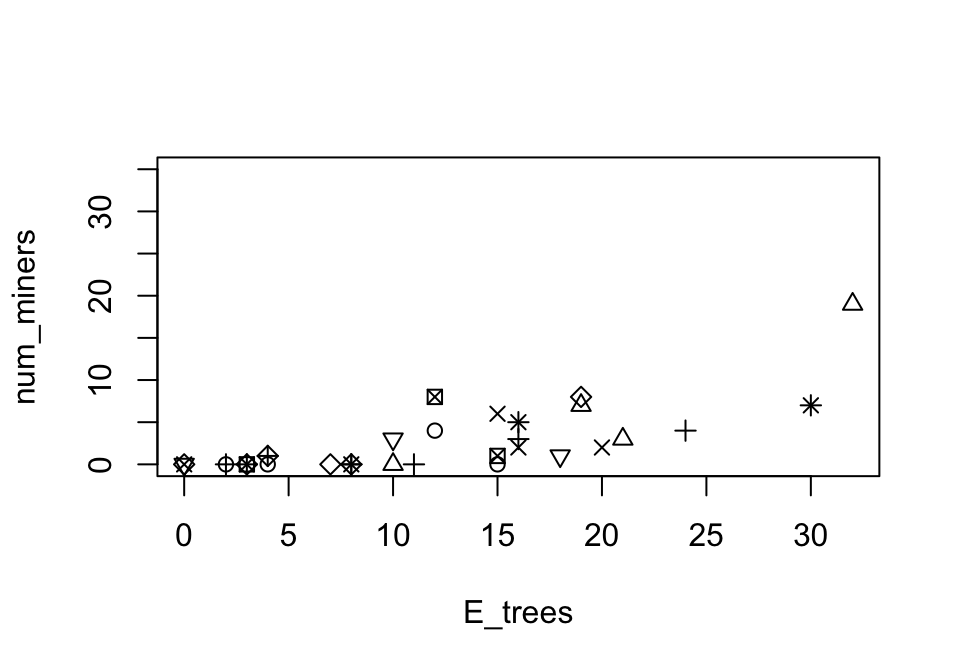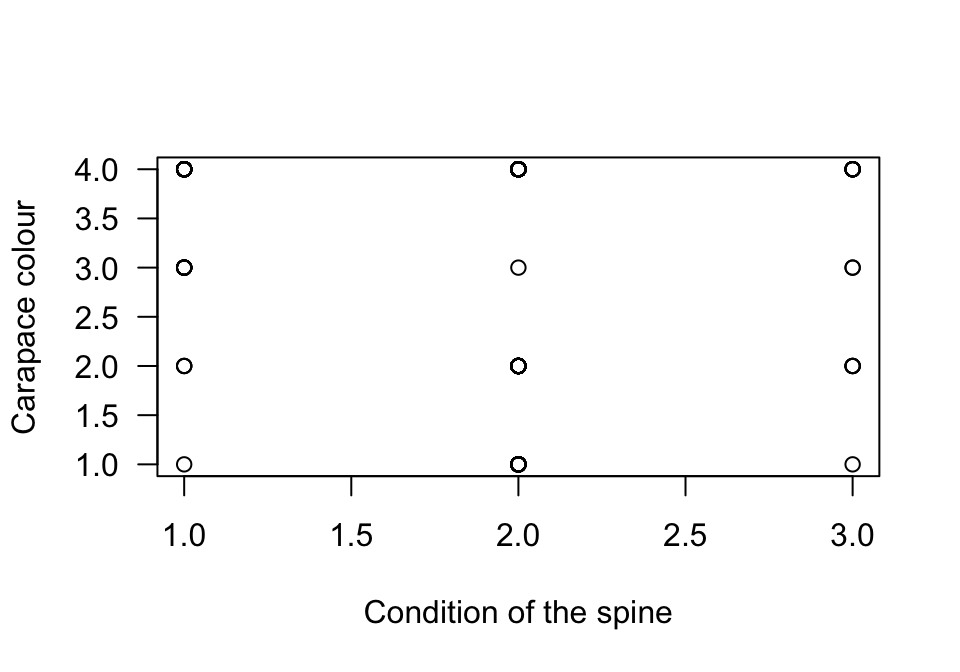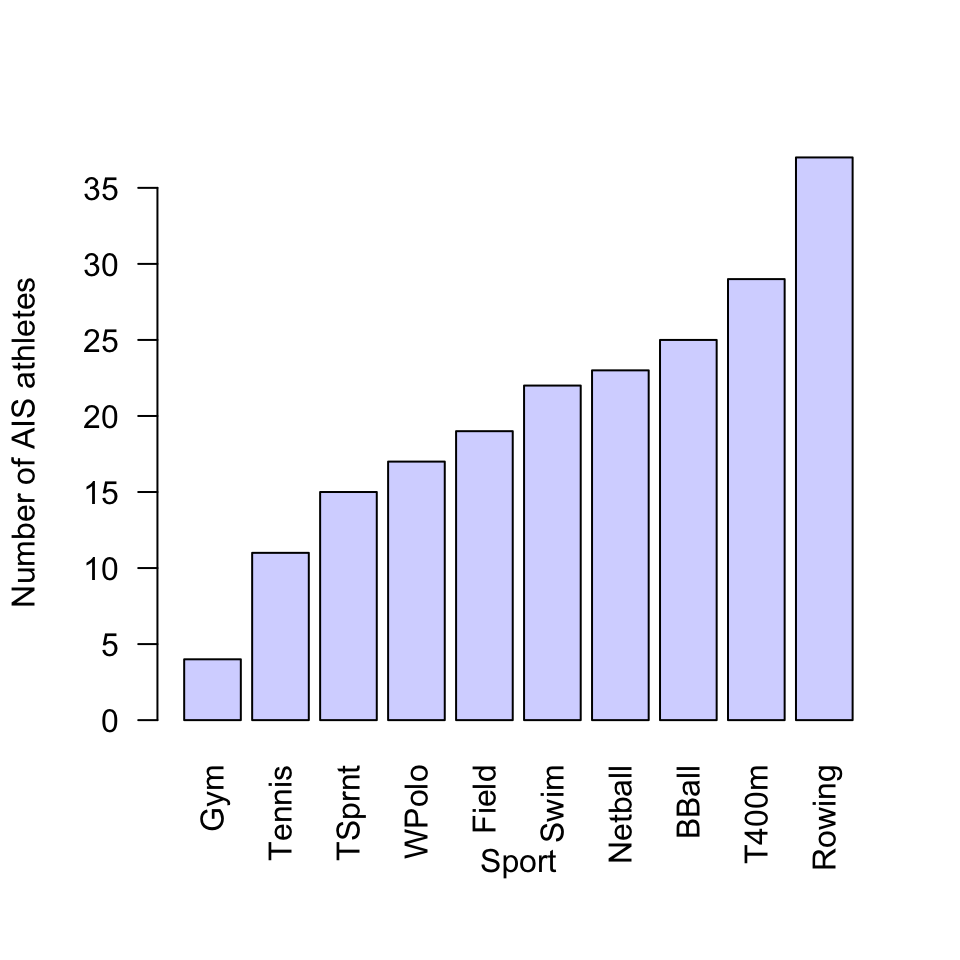Exercises
Selected answers are available in
Sect. D.12.
Exercise 12.1
A study
(Henderson and Velleman 1981)
recorded the number of cylinders in many models of cars
(Table 12.7).
The number of cylinders is quantitative discrete,
but with so few different values,
this variable could be plotted with some of the graphs
used for graphing qualitative data.
For these data:
- Produce a dot chart.
- Produce a histogram.
- Produce a bar chart.
- Produce a pie chart.
What graph do you think is best? Why?
TABLE 12.7: The number of cylinders in cars in a study
|
Number of cylinders
|
Number of cars
|
|
4
|
11
|
|
6
|
7
|
|
8
|
14
|
Exercise 12.2
A study of lime trees
(Tilia cordata)
recorded these variables for 385 lime trees in Russia
(Schepaschenko et al. 2017; Dunn and Smyth 2018):
- the foliage biomass, in kg;
- the tree diameter (in cm);
- the age of the tree (in years); and
- the origin of the tree (one of Coppice, Natural, or Planted).
The purpose of the study is to estimate the foliage biomass from the other variables.
What graphs would be useful?
Exercise 12.3
In a study of the influence of using ankle-foot orthoses in children with cerebral palsy
(Swinnen et al. 2017),
the data in
Table
11.2 describe the 15 subjects.
(GMFCS is an
ordinal variable used to describe the impact of cerebral palsy on their motor function:
the
Gross Motor Function Classification System.)
Sketch some graphs to explore the
relationships between these variables.
Exercise 12.4
A study of fertilizer use
(Lane 2002; Dunn and Smyth 2018)
recorded the soil nitrogen after applying different fertilizer doses.
These variables were recorded:
- the fertilizer dose, in kilograms of nitrogen per hectare;
- the soil nitrogen, in kilograms of nitrogen per hectare; and
- the fertilizer source; one of ‘inorganic’ or ‘organic.’
What graphs would be useful for understanding the data?
Exercise 12.5
A survey of voice assistants (e.g., Amazon Echo; Google Home; etc.)
conducted by Nielsen
asked respondents to indicate how they used their voice assistant;
options given were:
- Listening to music;
- Search for real-time info (e.g., traffic; weather);
- Search for factual info (e.g., trivia; history);
- Listen to news;
- Chat with voice assistant for fun;
- Use alarms, timer.
What would be the best graph for displaying respondents answers?
Would a pie chart be suitable? Explain your answer.
Exercise 12.6
A study of athletes at the Australian Institute of Sport (AIS)
measured numerous physical and blood measurements from high performance athletes
(Telford and Cunningham 1991).
The graph in
Fig.
12.40
compares the heights of females in two similar sports:
basketball and netball.
How would you describe the heights of
the athletes in the two sports?
Exercise 12.7
A study of noisy miners
(a small Australian bird)
counted the number of noisy miners
and the number of eucalyptus trees in random quadrats
(Maron 2007; Dunn and Smyth 2018).
Critique the graph
of the data
(Fig.
12.41).
Exercise 12.8
A study of 173 female horseshoe crabs
(Brockmann 1996; Dunn and Smyth 2018)
recorded,
among other things,
the colour of the carapace
(one of ‘Light medium,’ ‘Medium,’ ‘Dark medium’ or ‘Dark’)
and the condition of the carapace
(one of ‘Both OK,’ ‘One OK,’ ‘None OK’).
Critique the scatterplot
(Fig.
12.42)
used to explore the data.
Exercise 12.9
A study
(Danielsson et al. 2014) examined the change in MADRS
(a quantitative scale measuring level of depression)
and treatment group
(whether each person was treated using:
exercise; body awareness; or advice).
- What is the response variable?
- What is the explanatory variable?
- What graphs would be useful for exploring the data and the relationships of interest?
Exercise 12.10
In a study of the temperature in offices,
Paul and Taylor (2008)
compared the temperature in three offices (during working hours) at Charles Sturt University (Australia);
the data are summarised in Table
12.8.
Using this information, draw the boxplot comparing the three offices.
What do we learn from this graph?
TABLE 12.8: A summary of the temperature (in degrees C) in three offices at CSU during working hours according to current smoking status
|
|
Office A
|
Office B
|
Office C
|
|
Mean
|
24.1
|
25.3
|
25.7
|
|
Minimum
|
16.4
|
15.9
|
20.1
|
|
\(Q_1\)
|
22.8
|
23.8
|
24.6
|
|
Median
|
24.4
|
25.5
|
26.1
|
|
\(Q_3\)
|
25.5
|
26.9
|
27.2
|
|
Maximum
|
27.4
|
31.0
|
30.3
|
Exercise 12.11 A study of high-performance athletes at the Australian Institute of Sport (AIS)
(Telford and Cunningham 1991)
recorded numerous variables about athletes.
A plot for the sports played by the athletes is shown in
Fig.
12.43.
How would you describe the data:
Left skewed, right skewed, approximately symmetrical?
Or something else?
Brockmann HJ. Satellite male groups in horseshoe crabs, Limulus polyphemus. Ethology. 1996;102:1–21.
Danielsson L, Papoulias I, Petersson E-L, Carlsson J, Waern M. Exercise or basic body awareness therapy as add-on treatment for major depression: A controlled study. Journal of Affective Disorders. 2014;168:98–106.
Dunn PK, Smyth GK. Generalized linear models with examples in R. Springer; 2018.
Henderson HV, Velleman PF. Building multiple regression models interactively. Biometrics. JSTOR; 1981;391–411.
Lane PW. Generalized linear models in soil science. European Journal of Soil Science. 2002;53:241–51.
Maron M. Threshold effect of eucalypt density on an aggressive avian competitor. Biological Conservation. 2007;136:100–7.
Paul WL, Taylor PA. A comparison of occupant comfort and satisfaction between a green building and a conventional building. Building and Environment. 2008;43:1858–70.
Schepaschenko D, Shvidenko A, Usoltsev VA, Lakyda P, Luo Y, Vasylyshyn R, et al. A dataset of forest biomass structure for Eurasia. Scientific Data. 2017;4:1–1.
Swinnen E, Baeyens J-P, Mulders B Van, Verspecht J, Degelaen M. The influence of the use of ankle-foot orthoses on thorax, spine, and pelvis kinematics during walking in children with cerebral palsy. Prosthetics and Orthotics International. 2017;2017.
Telford RD, Cunningham RB. Sex, sport, and body-size dependency of hematology in highly trained athletes. Medicine and Science in Sports and Exercise. 1991;23(7):788–94.



